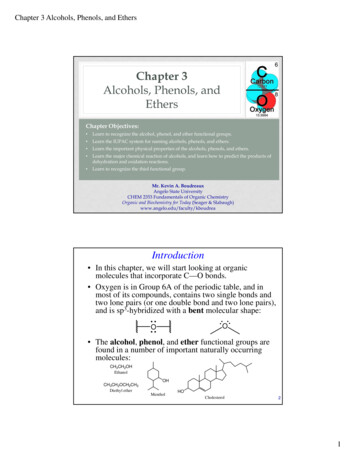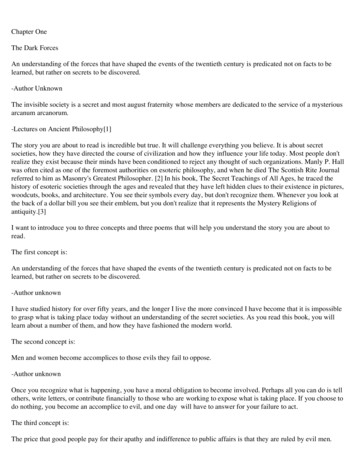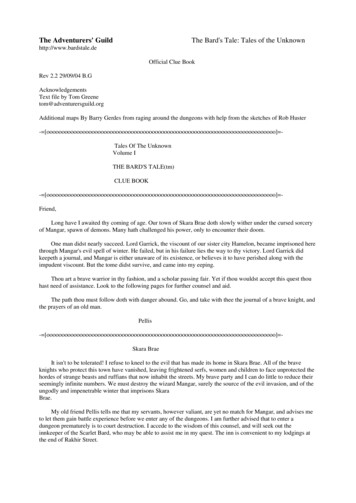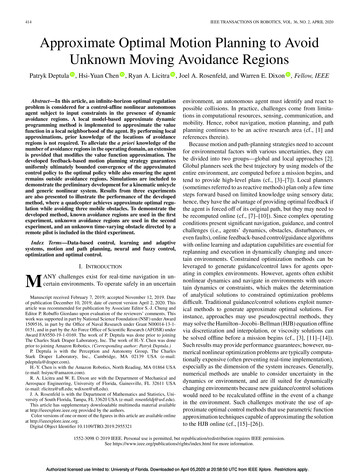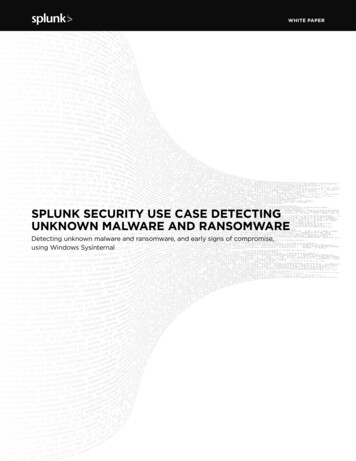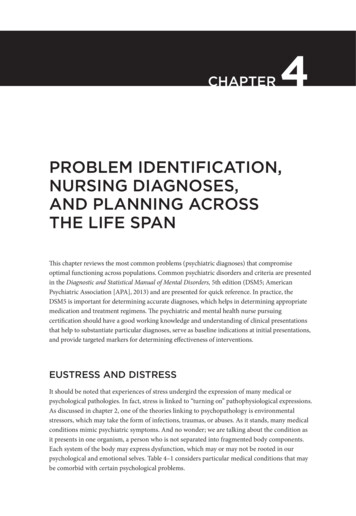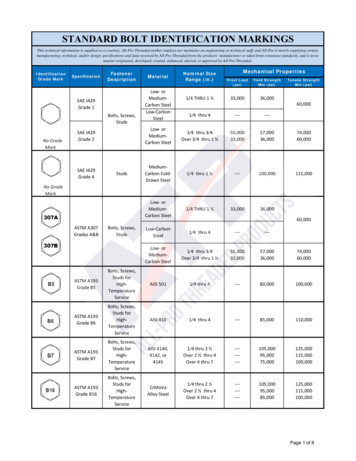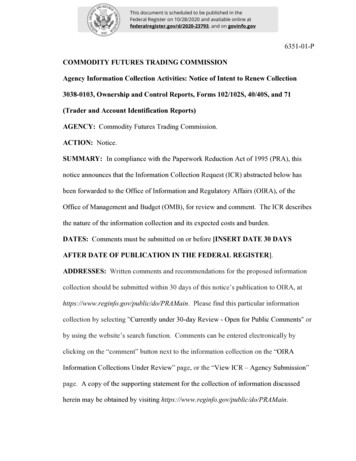
Transcription
Identification of an Unknown: Alcohols, Aldehydes, and KetonesHow does one determine the identity and structure of an unknown compound? This is not a trivial task.Modern x-ray and spectroscopic techniques have made the job much easier, but for some very complexmolecules, identification and structure determination remains a challenge. In addition to spectroscopicinformation and information obtained from other instrumental methods, chemical reactions can provideuseful structural information, and physical properties can contribute significantly to confirming theidentity of a compound.In this experiment, you will be asked to identify an unknown liquid, which will be either an alcohol,aldehyde, or ketone. Identification will be accomplished by carrying out chemical tests, calledclassification tests, preparing a solid derivative of the unknown and determining its melting point (MP),making careful observations, and analyzing the NMR spectrum of the unknown.the carbonylgroupOROHalcoholRHaldehydeORRketoneA list of alcohols, aldehydes, and ketones, along with the MP of a solid derivative of each compound, isposted on the website. The unknown will be one of these listed compounds. If one can determine towhich functional group class (alcohol, aldehyde, or ketone) the unknown belongs, two of the three listsneed not be considered and the task will be greatly simplified. To accomplish this, classification testswill be carried out. First, consider some general ways in which alcohols, aldehydes, and ketones react.1
CLASSIFICATION TESTS, which are simple chemical reactions that produce color changes or formprecipitates, can be used to differentiate alcohols, aldehydes, and ketones, and also to provide furtherstructural information. Because color plays such an important role in this experiment, a separate handouton this topic is available on the course website.2,4-Dinitrophenylhydrazine: Aldehydes and ketones react with 2,4-dinitrophenylhydrazine reagent toform yellow, orange, or reddish-orange precipitates, whereas alcohols do not react. Formation of aprecipitate therefore indicates the presence of an aldehyde or ketone. The precipitate from this test alsoserves as a solid derivative. A discussion on derivatives will be given later in this handout. Themechanism of this reaction is that of imine formation and can be found in any organic lecture text.OH 2N RNO2HNa series of stepsRNNO2HNNO2a ketone if . . . R carbonan aldehyde if . . . R HNO2a 2,4-DNP hydrazone(generally a solid)2,4-DNPCeric Ammonium Nitrate (CAN): Alcohols react with this yellow reagent to produce a color change(from yellow to red), but the carbonyl group is unreactive. This is a good experiment to test for thepresence of an alcohol or to prove the absence thereof. Note that changing the groups attached to certaininorganic ions such as Ce4 results in a change to the electronic structure, which results in a color change.Production of a magenta color, therefore, indicates the presence of an alcohol group. The 2 ammoniumcations are present as spectators and do not participate.R OH(NH4)2[Ce(NO3)6]an alcohol2-CAN, a yellow solidRO2Ce(NO3)5an alkoxy cerium(IV) derivativeSchiff’s Reagent: Before looking at the reaction of Schiff’s reagent, consider a much simpler system.The sulfur in the bisulfite ion acts as a nucleophile and adds to the carbonyl carbon. Because this is sucha bulky nucleophile, it will add only to a relatively sterically unhindered carbonyl. This requires thecarbonyl to be part of an aldehyde in which one of the R groups is the very small hydrogen, or a ketonehaving small ‘R’ groups. A ketone having large groups attached to the carbonyl will not react withbisulfite.OHOSO ObisulfiteRORaldehyde or stericallyunhindered ketoneORSOOHRbisulfite additioncomplexAldehydes react with Schiff's reagent to produce a color change (magenta-colored addition product). Inthe same way, the Schiff reagent acts as a nucleophile that adds to the carbonyl group of an aldehyde.2
Because this nucleophile is extremely bulky, a ketone, which is more sterically crowded than an aldehydeat the carbonyl carbon, does not react with Schiff's reagent, and thus does not produce the magenta color.Production of the magenta color therefore indicates that the unknown is an aldehyde and not a ketone.Note that generally, more extended systems of conjugation lead to colored compounds. Whereas theSchiff reagent itself has a limited system of conjugation, the adduct with an aldehyde has an extendedsystem of conjugation, resulting in a highly colored compound. More can be found on color in thesupplemental handout on the course website.SCHIFF TEST FOR ALDEHYDESNHSO2H(Very HinderedNucleophile)RHHO2SNH2OAldehyde(Ketone is too hindered- does not react)SO3HRNHSO2 C OHSchiff ReagentLimited Number ofResonance FormsNHSO2H3 moleculesof aldehydeHRHO C SO2NHCOLORLESSHRSchiff AdductHighly ConjugatedNHSO2 C OHH(13 resonance forms)MAGENTA COLORThe results of these classification tests will allow the unknown to be classified as an alcohol, an aldehyde,or a ketone. Additional structural information can be obtained from the iodoform test.Iodoform Reaction: The iodoform test indicates the presence of an aldehyde or ketone in which one ofthe groups directly attached to the carbonyl carbon is a methyl group. Such a ketone is called a methylketone. In the iodoform test, the unknown is allowed to react with a mixture of excess iodine and excesshydroxide. Hydrogens alpha to a carbonyl group are acidic and will react with the hydroxide to form theanion, which then reacts with iodine to form an alpha-iodo ketone. In a methyl ketone, all three alphahydrogens are substituted by iodine in this way to form the triiodo compound, which then reacts withmore hydroxide to form the carboxylate salt plus iodoform, a yellow precipitate. Formation of a yellowprecipitate therefore indicates the presence of a methyl group directly attached to the carbonyl.OOOPhexamples of methyl ketonesOOPhPhketones, but not methyl ketones3
The mechanism of the iodoform reaction is that of alpha-halogenation of a carbonyl compound underbasic conditions, followed by nucleophilic displacement of the resulting triiodomethyl group byhydroxide. The mechanism is outlined below where all inorganic by-products are omitted for clarity.OH HHOI2OHHIOHIIIHOIIHOOIIHIgood leaving groupHIIOHI OIHIHOOHOIIIOOI HOIO IIOI IIiodoform,a precipitateDERIVATIVE FORMATION: Simple chemical reactions that convert a liquid into a solid derivativeprovide another key piece of information. Why is it that the liquid unknown changes to a solid derivative?The unknown has a relatively low molecular weight (MW) and relatively low polarity, causing it to bea liquid at room temperature (RT). Derivatives are chosen to have a high MW and very high polarity,causing them to be solids at RT. The solid derivative is purified by recrystallization, and its MPdetermined. The MP is then matched against the MPs of derivatives of the posted compounds. In thisway the number of possibilities can be narrowed down to just a few compounds.2,4-Dinitrophenylhydrazones: As shown above, both aldehydes and ketones react with 2,4dinitrophenylhydrazine (DNP) to form a solid DNP derivative. The classification test serves also asderivative formation. The color of this derivative can also provide useful structural information. If thesolid is yellow, this most often means that the carbonyl group in the unknown is non-conjugated. Areddish-orange color most likely means that the carbonyl group is conjugated. There are exceptions tothis, so care should be taken when interpreting this observation. In a few cases, compounds in which thecarbonyl group is not conjugated produce orange precipitates. Note carefully that simply having a doublebond or phenyl group somewhere in an aldehyde or ketone does not necessarily mean that the carbonylgroup is conjugated. The double bond must be separated from the carbonyl by one single bond only. Ifthe double bond is further away, it is isolated from the carbonyl and not conjugated with the carbonyl.4
OOOOconjugated carbonylsnon-conjugated carbonyls3,5-Dinitrophenylbenzoates (3,5-DNB): Alcohols react with 3,5-dinitrobenzoyl chloride to producesolid 3,5-DNB esters that follows the mechanism outlined below.NO2ROHR'OCl ClORNO2OHR'OOR ClH3,5-dinitrobenzoylchlorideNO2Rwhere R' OR'Oa 3,5-DNB EsterNO2SUMMARY: The results of the classification tests enable one to limit the search to one of three lists ofpossible compounds. The results of these tests will provide information on whether the unknown is analcohol, aldehyde, or a ketone, and if it is an aldehyde or ketone, whether it is a methyl aldehyde orketone, and possibly whether the carbonyl group is conjugated or not. Narrowing the possibilities furtherrequires carefully obtaining the melting point of the purified solid derivative. Once this has beendetermined, the list of possible compounds, along with the MPs of the derivatives, can be consulted. Formany unknowns, the MP of the derivative, together with the results of the classification tests will providesufficient information to make a final conclusion as to the identity of the compound. Often, however,two or even three possibilities may have very similar test results and derivative MPs. In such a case, theNMR spectrum can be used to make a final determination.A SAMPLE ANALYSIS: Unknown X produces a red/orange DNP, MP 159-161 and gives a neg Schiffand neg iodoform test. Pos DNP - ald or ket. Red/orange DNP - probably conjugated carbonyl. NegSchiff - not ald, therefore ketone. Neg iodoform - not methyl ketone. Look up MP of derivative intable of ketones. Three compounds fall within likely range: cyclohexanone, isobutyrophenone, and 1methoxy-2-propanone.OOOOcyclohexanone,a non-conjugatedcarbonylisobutyrophenone,a conjugated carbonyl1-methoxy-2-propanone,a methyl ketone5
The results point towards isobutyrophenone as being the unknown. 1H-NMR would readily confirm thisby indicating the presence of aromatic hydrogens and the common splitting pattern of an isopropyl group.Use the following flow diagram to help carry out the experiment.Unknown- recyst ppt- dry- mp2,4-DNPHnopptpptaldehydeor ketonealcoholCe 4yellowto redalcohol3,5-DNBCno colorchangeNOT alcoholSchiffno colorchangemagentaaldehydeketonepptI2 /OH- recyst ppt- dry- mpyellowpptmethyl ald/ketno pptnot methyl ald/ketPrelab: You may either print out your prelab and bring it with you to lab, or bring your computer.Your TA will grade it on the spot before you begin the experiment. For the in lab observations,you may use scratch paper and record later in your ELN, or bring your computer and recorddirectly in your ELN.Postlab Report: Make sure to use the non-formal postlab report template on the course website!THE EXPERIMENT: (revised 4/20). Note that an incorrect identification of unknown will result in anautomatic deduction of 5 points (10%).WARNING: acetone is a methyl ketone. If it is used to clean glassware, the glassware must becompletely dried or else the acetone will interfere with your results. Be careful to not accidentallycontaminate reagent bottles by using pipets contaminated with acetone, known compounds or unknowns.Many of the unknowns have a very disagreeable odor. To minimize this odor in the lab, be sure to rinseused pipets with a LITTLE acetone in the hood before disposing of them in the boxes in the waste hoodlabeled “contaminated pipets”. Do not dispose of them in the "Glass Only" waste boxes. The yellowpipet bulbs can be used indefinitely and should not be thrown out. It is not necessary to use a newpipet each time you measure out your unknown. Use the same one for the whole experiment. Conservewhenever possible.6
You will be assigned one unknown to identify. The unknown will be a liquid alcohol, aldehyde, orketone (taken from the list of possible compounds posted on the Chem 269 website). Record the numberof the unknown in your ELN. Each unknown is unique and will require a slightly different approach.The identification will be made by doing chemical classification tests, by determining the MP of aderivative, and by interpreting the 1H-NMR spectrum. From the results of the tests and the MP of thederivative, you will narrow the identity of the unknown to a few possible compounds. Once this is done,interpreting the 1H-NMR spectrum of the unknown will allow you to make a final conclusion.The amount of unknown that you are given is more than enough to do each test several times. Conserveit. If you need more, it will cost you 1 point. (Aldehydes oxidize to carboxylic acids in the presence ofoxygen and light. In the short amount of time that you will work in the lab, away from direct sunlight,this will not be a problem. If your unknown is an aldehyde and if for some reason you need to doadditional tests on another day, ask your TA to store the sample in the refrigerator until you need itagain.) Also note that some unknowns have low BPs and will evaporate unless kept tightly stoppered.Prelab exercise: as part of the prelab outline, summarize a logical approach to identifying your unknownby preparing a flow chart (use the chart above as a template but provide more detail).In heating reaction mixtures NEVER use a wooden boiling stick. Boiling sticks can be used only innonreactive solutions such as in recrystallizations.Carry out the procedure in the order given below. Success depends upon very careful work.(1) Reaction with 2,4-dinitrophenylhydrazine: Using the reagent pipet attached to the bottle, measure 2mL of the DNP reagent solution (2,4-dinitrophenylhydrazine dissolved in phosphoric acid and ethanol)into a reaction tube, and then, using your own "unknown" pipet, add 2 drops of liquid unknown. Theamounts need only to be approximate. Do not contaminate the reagent or its pipet with your unknown.Mix the solution thoroughly and allow it to stand at room temperature for a few minutes. During thistime, if the te
The precipitate from this test also serves as a solid derivative. A discussion on derivatives will be given later in this handout. The mechanism of this reaction is that of imine formation and can be found in any organic lecture tex t. R O NO 2 NO 2 H N H 2N a series of steps NO 2 NO 2 H N R N a ketone if . . . R carbon an aldehyde if . . . R H 2,4-DNP a 2,4-DNP hydrazone (generally a .
